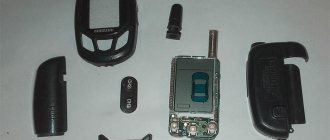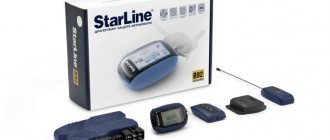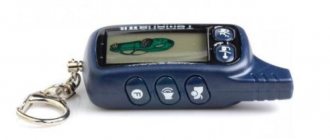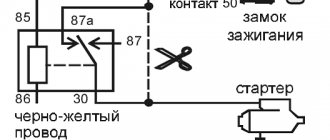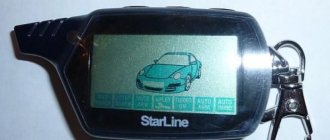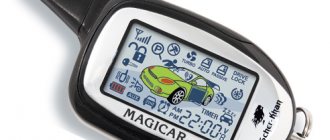A turbo timer is a device that allows you to maintain current in the ignition circuit when the key is already in the OFF or ACC position. The time before the timer turns off is set programmatically - it can be 60 seconds, 2 minutes, and so on. Often the turbo timer option is implemented based on alarms, and without installing additional equipment. As a last resort, you will need to install a relay controlled from the alarm output. The Sheriff ZX 750 system, which is discussed below, was no exception to the rule. One relay is connected to it and you get a working turbo timer. But the connection can be made in one of three ways, and these methods are discussed further.
Important In the key fobs transmitters included in this kit…
Zx 750
- Image
- Text
1
Important
The key fobs transmitters included in the kit of this security system use
uses dynamic encoding of the transmitted control code package, which makes attempts to scan or memorize the code (code grabbing) for the purpose of its subsequent reproduction completely useless, since any subsequent control command of the transmitter key fobs changes every time the button is pressed. Therefore, when the hijacker reproduces the intercepted signal from your transmitter key fob, the security system simply will not respond to it.
To provide the highest level of protection for your vehicle, this
The security system has a function for manually arming or disabling the security mode. In some cases, for example, when the key fob transmitter for remote control of the system is lost or does not work, or perhaps your key fob transmitter is blocked by powerful radio emissions from a jammer or code-swapping interceptor, you may need to manually arm or manually disarm the system. Read the sections “Manually arming the system” and “Manually disabling the security system,” which detail the procedures for arming and disarming the system in such a situation.
To effectively combat interception systems with code substitution ALWAYS
try to turn on (turn off) the security mode from the transmitter key fob by bringing it as close as possible to the system antenna if previous attempts were unsuccessful. This will automatically make the previous code inoperative and eliminate the possibility of substitution. To increase the level of vehicle protection, also use the phased system shutdown mode.
If the F13 “Secret Code” function is programmed, then recording the codes
new key fobs, changing the secret code, changing the status of programmed functions from F12 to F20, emergency disarming of the system, turning off the system when triggered in the “Anti Hi Jack” modes are possible only after entering the secret code! Changing the parameters of functions F1 to F11 does not require entering a secret code and is always available.
Car security system with two-way communication, three service channels, interactive LCD pager, anti-theft and car hijacking protection systems.
Installation and Use Guide
ZX 750
How to install
The installation documentation recommends securing the headunit housing inside the vehicle using 2 screws. It is prohibited to mount the unit in the engine compartment, since the casing does not protect the electronic components from moisture. It is not recommended to install the unit next to the car's standard controllers (due to the risk of electromagnetic interference). To mount the siren on the engine shield, a metal bracket is used, the bell is tilted down (to drain condensate).
The antenna unit is attached to the windshield using 2-sided tape. Since there is an LED on the unit, it is necessary to ensure visibility of the element from the driver’s seat and from the outside through the car window. An additional limit switch is installed on a metal body panel outside the water drainage area. It is recommended to place the element inside the protective contour formed by the rubber sealing edge. To reduce the risk of false alarms, it is necessary to adjust the switch stroke in the range of 6-8 mm.
Wiring connection
The manual for the 750 series signaling shows a diagram of connecting the main and auxiliary harnesses. The cables are equipped with multi-colored insulation, which simplifies the alarm connection procedure.
The equipment allows you to use a standard car horn instead of a siren (after installing an additional unloading relay).
The documentation provides recommendations for connecting the complex to cars from different manufacturers; the alarm design includes support for vacuum drives of the central locking system.
Contents Main functions of the Sheriff ZX system ...
Page 2
- Image
- Text
2
Table of contents
Basic functions of the Sheriff ZX 750 system. . . . . . . . . . . . . . . . . . . . . . . . . . . . . . . . . . . . . . . . . . . . . . . . . . .4
Controlling the operation of the Sheriff ZX 750 system
. . . . . . . . . . . . . . . . . . . . . . . . . . . . . . . . . . . . . . . . . . . . . . .6
Functions of transmitter key fob buttons. . . . . . . . . . . . . . . . . . . . . . . . . . . . . . . . . . . . . . . . . . . . . . . . . . . . . .6 Combinations of LCD indicators. . . . . . . . . . . . . . . . . . . . . . . . . . . . . . . . . . . . . . . . . . . . . . . . . . . . . . . . . . . . . . .7 Programming codes for new transmitters and anti-robbery transponders. . . . . . . . . . . . . .9 Commands for controlling the Sheriff ZX 750 system from the transmitter key fob. . . . . . . . . . . . . . . . . . . . . . . . . .11 Remote (two-way communication key fob) activation/deactivation of system functions. . . . . . .14 Confirmation signals of the two-way communication key fob of the Sheriff ZX 750 system. . . . . . . . . . . . . . . . .17 Operating modes of the security system LED indicator. . . . . . . . . . . . . . . . . . . . . . . . . . . . . . . . .20 Siren signals. . . . . . . . . . . . . . . . . . . . . . . . . . . . . . . . . . . . . . . . . . . . . . . . . . . . . . . . . . . . . . . . . . . . . . . . . . .20 Operating modes of vehicle side lights. . . . . . . . . . . . . . . . . . . . . . . . . . . . . . . . . . . . . . . . . . . . . . .20 Low battery indicator/battery replacement. . . . . . . . . . . . . . . . . . . . . . . . . . . . . . . . . . . . . . . . . .21
Additional commands for arming the system
. . . . . . . . . . . . . . . . . . . . . . . . . . . . . . .22
Passive (automatic) arming of the system. . . . . . . . . . . . . . . . . . . . . . . . . . . . . . . . . . .22 Manually arming the system. . . . . . . . . . . . . . . . . . . . . . . . . . . . . . . . . . . . . . . . . . . . . . . . . . . . . . .22 Arming with the engine running (“Any Stop”). . . . . . . . . . . . . . . . . . . . . . . . . . . . . . . . .23
Car protection in security mode
. . . . . . . . . . . . . . . . . . . . . . . . . . . . . . . . . . . . . . . . . . . . . . . . . . . .23
Protecting the car when the security mode is on. . . . . . . . . . . . . . . . . . . . . . . . . . . . . . . . . . . . . . . . .23 Warning signals about an attempt to break into a car. . . . . . . . . . . . . . . . . . . . . . . . . . . .24 Control of coded blocking relay R350 - function F20 (additional option). . . . . . . . . . .24
Disabling the system
. . . . . . . . . . . . . . . . . . . . . . . . . . . . . . . . . . . . . . . . . . . . . . . . . . . . . . . . . . . . . . . . . . . . .25
Valet button. . . . . . . . . . . . . . . . . . . . . . . . . . . . . . . . . . . . . . . . . . . . . . . . . . . . . . . . . . . . . . . . . . . . . . . . . . . . .25 Manual disabling of the security system using the “Valet” switch. . . . . . . . . . . . . . . . . . . . . .25 Disabling the system using a personal code. . . . . . . . . . . . . . . . . . . . . . . . . . . . . . . . . . . . . . . . .25 Service mode “Valet” (temporary shutdown of the system). . . . . . . . . . . . . . . . . . . . . . . . . . . . . . . . . .26
Additional security features
. . . . . . . . . . . . . . . . . . . . . . . . . . . . . . . . . . . . . . . . . . . . . . . . . . . . . . .26
Additional (emergency) call using the antenna module button. . . . . . . . . . . . . . . . . . . . . . . . . . . . . .26 Automatic safe locking of doors when the vehicle starts moving (function F10.2). . .26 Automatic safe locking of doors when pressing the “C top” pedal of the car (function F10.3). . . . . . . . . . . . . . . . . . . . . . . . . . . . . . . . . . . . . . . . . . . . . . . . . . . . . . . . . . . . . . . . . . . . . . . . . . . .26 Step-by-step sequential unlocking of the driver's then passenger doors (functions F18.1). . . . . . . . . . . . . . . . . . . . . . . . . . . . . . . . . . . . . . . . . . . . . . . . . . . . . . . . . . . . . . . . . . . . . . . . . . . .27 Automatic re-arming of the system (function F6). . . . . . . . . . . . . . . . . . . . . . . . . . . . .27 Disarming the system in two stages - AV function (function F14). . . . . . . . . . . . . . . . . . . . . . . . . . .27 Passive engine blocking (immobilizer function F15) . . . . . . . . . . . . . . . . . . . . . . . . . . . . . .27 “Anti Hi Jack” mode (protection against car theft and seizure). . . . . . . . . . . . . . . . . . . . . . . . . . . . . . . .28 Disabling the “Anti Hi Jack” mode. . . . . . . . . . . . . . . . . . . . . . . . . . . . . . . . . . . . . . . . . . . . . . . . . . . . . . . . .28
Specifications
Technical parameters of the alarm Sheriff ZX:
- operating voltage - from 9 to 15 V (DC);
- current consumption (in standard security mode) - no higher than 20 mA;
- operating temperature - -40…+85°С;
- transmission range of control signals (head console) - up to 900 m;
- working radius of the auxiliary key fob - up to 70 m;
- distance for receiving information from the car - up to 2000 m;
- signal encryption type - dynamic code CFM-II;
- signal broadcast frequency - 433.92 MHz.
Equipment
The following parts are included in the security alarm kit:
- head block of the complex;
- a communicator equipped with a liquid crystal display;
- auxiliary control panel;
- antenna unit with integrated LED;
- 2-zone shock sensor;
- parameter adjustment button;
- additional limit switch;
- siren (optional);
- a set of switching harnesses and technical documentation.
Additional service functions for security system management…
Page 3
- Image
- Text
3
Additional service functions for security system management
. . . . . . . . . . . . . . . . . . .29
Remote control of the siren (on/off, night mode of the system). . . .29 Automatic door unlocking when the ignition is turned off (function F11). . . . . . . . . . . . . . . . .29 Remote control of additional devices (CH 2) . . . . . . . . . . . . . . . . . . . . . . . . . . .29 Turning on/off external devices (starting the engine) (function F19.3) . . . . . . . . . . . . . . .thirty
Security system programming
. . . . . . . . . . . . . . . . . . . . . . . . . . . . . . . . . . . . . . . . . . . . . . . . . . .31
Programming system functions. . . . . . . . . . . . . . . . . . . . . . . . . . . . . . . . . . . . . . . . . . . . . . . . . . . . . . . .31 Changing the personal system deactivation code. . . . . . . . . . . . . . . . . . . . . . . . . . . . . . . . . . . . . . . . .32 Table of programmable functions of the Sheriff ZX 750 system. . . . . . . . . . . . . . . . . . . . . . . . . . . . . . . . . .33 Brief description of system functions. . . . . . . . . . . . . . . . . . . . . . . . . . . . . . . . . . . . . . . . . . . . . . . . . . . . . . . . .35
System installation
. . . . . . . . . . . . . . . . . . . . . . . . . . . . . . . . . . . . . . . . . . . . . . . . . . . . . . . . . . . . . . . . . . . . . . .36
Appendix 1. Remote digital locking relay R350, R350NC. . . . . . . . . . . . . . . . . . . . . . . . . . .52
Additional functions
Page 5
- Image
- Text
Additional functions
•
“Save” mode—controls the power saving of the two-way communication key fob.
•
Remote control of the “Turbo timer” function (on/off).
•
Temporary blocking of LCD key fob buttons.
•
Remote activation/deactivation of the “Valet” service mode.
•
Search for a car in a parking lot.
•
Remote control of the siren channel in security mode (disable/enable - night mode).
•
Temporarily disabling the shock sensor when arming.
•
Silent communication control mode (manual mode), checking, updating the LCD screen status.
5
Page 38
To install the Valet switch, select a location where the vehicle driver can easily use it. It is recommended to use certain camouflage methods, which will increase the level of system security and make it more difficult for hijackers. The Valet push-button switch can be mounted on the lower driver's side of the vehicle's dashboard.
To install the impact sensor, select a flat, hard surface on the partition separating the engine compartment and the vehicle interior, on the passenger side. Attach the shock sensor to the selected location using two self-tapping screws. The sensor can also be mounted on the pillars to which the car’s dashboard is attached using cable ties. Regardless of which method of mounting the shock sensor is used, it is necessary to ensure free access to the potentiometer for adjusting the sensitivity of the sensor, which may be required for subsequent system setup.
Connecting system wires
When connecting additional relays to the security system outputs, make sure that there is a damping diode on the relay control contacts. Connect the security system output to the additional relay only from the anode side of the snubber diode. Make all connections to the security system wires only with the security system power circuit fuses removed. If there is no damping diode in the additional relay, the polarity of its connection is arbitrary.
Controlling the operation of the sheriff zx 750 system
Page 6
- Image
- Text
Controlling the operation of the Sheriff ZX 750 system
Functions of transmitter key fob buttons
Functions of transmitter key fob buttons
Button for arming the system (ARM) Button for disarming the system (DISARM) Button for controlling the programmable channel CH2, controlling system modes when arming/disarming the system Button “ ” for remote selection of functions and changing system parameters
6
Rice. 1
Attention
In order to increase the battery life of the two-way communication key fob, the presence of communication between it and the central unit of the system is monitored manually. To check the presence of communication with the key fob pager and the system, issue a command by pressing any button except F. If the connection is present, the system will “return” confirmation of the command execution with a corresponding sound signal. Otherwise, after 3 seconds the LCD indicator
antenna will disappear from the screen and the buzzer will
will give one long and one short signal.
A little about choosing an alarm manufacturer
ATTENTION! A completely simple way to reduce fuel consumption has been found! Don't believe me? An auto mechanic with 15 years of experience also didn’t believe it until he tried it. And now he saves 35,000 rubles a year on gasoline! Read more"
The most popular and effective car security equipment today is considered to be a car alarm from the well-known manufacturer Sheriff. The system is connected by specialists; you can try to install it yourself; the instructions will help you with this. In addition, the millet kit is in operation and maintenance.
The quality of workmanship speaks for itself, but the alarm system of this level also differs in the following parameters:
- window/door locking function;
- the presence of a special satellite module;
- audio wiretapping of the cabin;
- possibility of instant blocking of the engine.
These parameters significantly increase the level of security of the car. The Sheriff car alarm will allow you to detect your car if it is stolen, as well as prevent this fact. The detailed instructions that come with the anti-theft system will tell you in detail about all its features and installation methods.
Indicator for turning on the power saving mode of the pager key fob...
Page 7
- Image
- Text
7
Indicator for turning on the power saving mode of the pager key fob. The mode is turned on/off in the “Disarmed” mode by simultaneously pressing buttons 1+F(5) until the “Save” indicator appears or disappears. In the “Disarmed” mode, the pager key fob turns off its receiver after 30 seconds, as evidenced by the disappearance of the antenna indicator.
Valet mode activation indicator
(service mode).
Always present on the display while the system is in “Valet” mode.
System sensor status indicator.
The shock sensor is turned off. Triggering in the main zone of the shock sensor is disabled; arming by bypassing a faulty shock sensor. Flashes when the sensor is triggered by a strong impact.
Indicator for turning on the vibrate ringer mode.
“AUTO” indicator—activation of passive arming.
Indicator for turning on door locking during passive or manual arming.
Indicator of the siren sound signal when the “Security” mode is activated.
Indicator of siren deactivation in “Security” mode.
Indicator of anti-burglary function operation. Flashes when the Anti Hi Jack anti-theft feature is activated.
Engine running mode indicator. Flashes in active mode.
Indicator for receiving a call signal from inside the car. Flashes when receiving a call from the pager.
Indicator of operation of temporary timers.
Flashes when the time is counting down in the operating turbo timer mode.
Battery charge indicator (battery is fully charged).
The indicator blinks - low battery charge (less than 30%).
Indicators of activity of additional channels. Shows the status of the CH2 channel line.
Ignition on indicator. Shows the status of the vehicle's ignition line.
LCD display indicator combinations
Communication indicator (antenna).
Disappears if there is no connection with the central unit or if a request is made to execute a non-existent command.
Indicator of the enabled “Turbo timer” mode. Indicates that the mode is activated in the system.
Rice. 2
We determine the installation location of the Sheriff alarm system on the car
There's nothing special about it. The most optimal point for installing the central equipment of the system is the cavities located behind the dashboard. Before starting work, wrap the alarm unit with foam rubber, try on how best to position it, and it should be securely fixed and not interfere with anything.
Sheriff car alarms are installed in accordance with the following rules:
- The sensor is located in a hidden place inside the cabin; it must be hidden as best as possible so that it is difficult for an attacker to penetrate the system and disable it. It is impossible to determine the location using the wires, but getting it out will take time.
- Car alarms, that is, the unit should not be located near moving parts and components, near air conditioners and stoves.
- The sensor should not be located close to the radiation and reception of radio waves: antenna cables, radio stations, telephones.
The kit will be connected to the panel devices, in which case you will need additional wires. Compliance with all precautions and rules will allow the installation to be carried out efficiently. And now let's go directly to it.
Door status indicator: ...
Page 8
- Image
- Text
8
Door status indicator:
— on (doors locked)
with the ignition on or in “Valet” mode (service mode).
- off (doors unlocked)
us) with the ignition on or in the “Valet” mode (service mode).
System command execution indicator. The headlights are flashing.
Hood switch activation indicator. Flashes when the hood switch is triggered in the “Armed” mode or when arming with the hood open.
Door limit switch operation indicator. The door icon flashes when the system is triggered by the door limit switches or when arming bypassing faulty (unready) door limit switches.
Trunk limit switch activation indicator. Flashes when the trunk limit switch is activated in the “Security” mode or when arming with the trunk open.
Programming codes for new transmitters, Programming transmitters
Page 9
- Image
- Text
9
Programming codes for new transmitters
Important
Please note that when programming a new transmitter into the system memory, all previously programmed transmitter codes are erased, therefore, when programming additional transmitters, existing transmitters must be programmed again. The system maintains up to four key fob codes in memory, regardless of whether the codes are from four different key fobs or the same code is written into the system 4 times.
Transmitter programming
Recording codes for new transmitters (F13 - “Valet” state).
Important
Remember that each operation must be performed within 5 seconds after the previous operation. If the 5 second interval is exceeded, the system will automatically exit the programming mode, which will be confirmed by one short and one long beep from the siren. If the ignition was turned off during programming, the system will immediately exit the programming mode, confirming this with one short and one long siren signal.
•
Disarm the system, get into the car and turn on the ignition.
•
Press the Valet button switch 3 times. You will hear one short siren signal. Click the Valet button again. You will hear a long siren tone indicating that the system is ready to program new transmitters.
•
Press and hold button 1 (see Fig. 1) of the first transmitter until you hear a long siren signal, confirming that programming of the first transmitter is completed (the transmitter channels will be programmed automatically). At the same time, the LED will begin to flash rapidly.
•
Press and hold button 1 (see Fig. 1) of the second transmitter until you hear a long siren signal confirming that programming of the second transmitter is complete. The LED will begin to flash slowly.
•
Repeat step 3 for the remaining transmitters.
•
To exit transmitter programming mode:
a) turn off the ignition or b) wait 8 seconds without performing any actions.
You will hear one short and one long siren signal to confirm exit
transmitter programming, and the system LED will go out.
Recording codes for new transmitters (F13 - “Secret code” state)
Disarm the system using a key fob or by entering a secret code with the “Valet” button, i.e. •
Turn on, turn off and then turn on the ignition;
•
Using the “Valet” switch, enter the first digit of the code (the number of presses of the “Valet” button corresponds to one digit of the code);
•
Turn off and then turn on the ignition;
•
Using the “Valet” switch, enter the second digit of the code (the number of presses of the “Valet” button corresponds to the second digit of the code);
•
Turn off and then turn on the ignition. The system should confirm with an audible signal that the correct code has been entered;
What you need to know when installing a Sheriff alarm yourself
With a variety of brands, there are also many schemes for installing equipment on a car. This suggests that pins with the same markings and colors may have different functions.
When purchasing a Sheriff alarm system and installing it, the main document you need to refer to is the instructions.
Regarding installing a GSM security kit yourself without the help of experienced craftsmen, you need to understand what it is, know how to program the equipment, which sensors are responsible for certain functions. If everything is in order with this, you can proceed to installing the alarm system.
Press the push button switch...
Page 10
- Image
- Text
•
Press the Valet button switch 3 times. You will hear one short siren signal. Click the Valet button again. You will hear a long siren signal confirming that the system is ready to program new transmitters;
•
Press button 1 (see Fig. 1) of the first transmitter key fob. The system will confirm the recording of the new key fob code into memory with a sound signal;
•
Press button 1 (see Fig. 1) of the second transmitter key fob. The system will confirm the recording of the new key fob code into memory with a sound signal;
•
Repeat step 3 for the remaining transmitters;
•
To exit transmitter programming mode:
a) turn off the ignition or b) wait 8 seconds without performing any actions.
You will hear one short and one long beep from the siren to confirm that you have exited the mode.
transmitters and the system LED will go out.
10
Comments
Select → I found instructions for my car alarm here! #manualza
- Click →
The owner of Ikea sold his soul to the devil, but he could not assemble it according to the instructions.
Manualza!manualza.ru
Still not with us?
Advantages and disadvantages
Advantages of the 750 models:
- Efficiency. At a relatively low price, Sheriff 750 alarm systems are characterized by operating efficiency under any conditions.
- Long service life. According to reviews, the alarm system of this model optimally performs its functions even several years after installation.
- Wide functionality. The options that the signaling has allow you to comfortably control not only the system itself, but also some components of the car. At a low cost, optionality will be a nice addition.
- Availability of feedback.
This model has more disadvantages than advantages:
- Small range of the communicator. The actual operating range of the remote control differs from that declared by the manufacturer. If there is interference on the ground, the operating radius can be reduced to several hundred meters.
- Quiet speaker on the pager. Users complain that the notifications that come to the device are played too quietly. It is not always possible to hear the signals that the alarm sends to the pager.
- The siren goes off for no reason. The device can trigger an alarm mode in the absence of physical impact on the car body. In fact, this may be due to incorrect settings of the sensitivity sensor. Proper adjustment can solve the problem.
- Fragile keychain. The device is sold in a weak case that is susceptible to breakage as a result of falls. Many consumers are faced with the need to repair their communicator.
- The appearance of signal malfunctions after a certain time. Although the service life of the anti-theft installation is quite long, problems appear over time. Alarms may go off for no reason, door locks may not lock, etc.
A brief overview of the capabilities and disadvantages of the signaling was given by user Yaroslav540.

